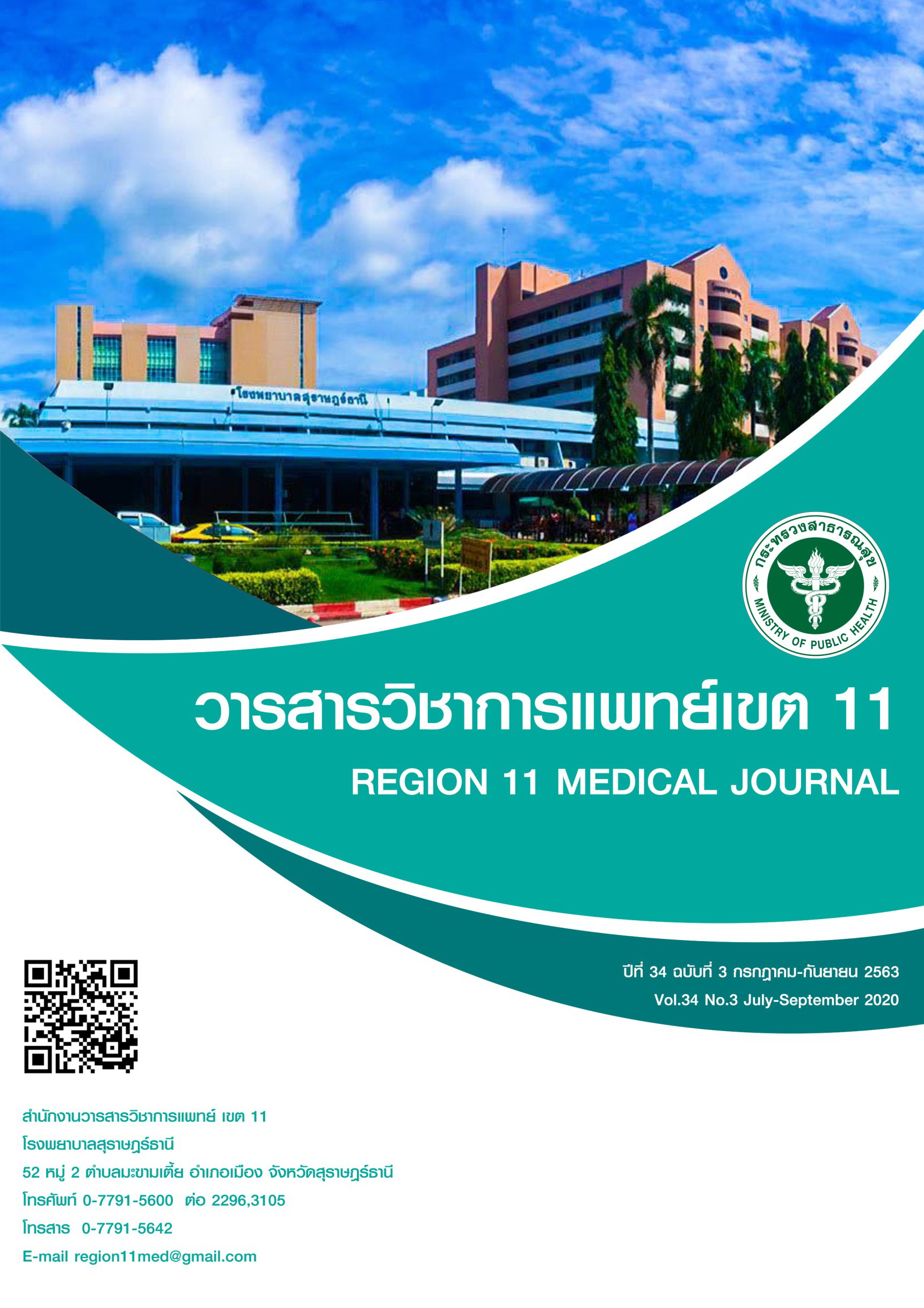Intelligence Level and Learning Ability in Reading, Writing and Calculating of the Second to Sixth Grade Students in Surat Thani Province
DOI:
https://doi.org/10.14456/reg11med.2020.2Keywords:
Intelligence level, learning ability, learning disabilityAbstract
Backgroud: Nowaday many Thai children have difficulty in one or more areas of learning such as dyslexia, dysgraphia or dyscalculia. It is important to identify children who may be at risk of learning problems and provide them an effective early intervention.
Objectives: To study an intelligence level and learning ability in reading, writing, and calculation of the second to sixth grade students in Surat Thani Province.
Method: This study was a retrospective descriptive study in 139 students of the second to sixth grade, The tools were the Coloured Progressive Matrices (CPM), the Standard Progressive Matrices (SPM) and the Wide Range Achivement Test (WRAT-Thai). The collected data were analyzed using descriptive statistics method.
Results: 1) An average intelligence level of the second to sixth grade students was 99.08. Most of male and female students had the average intelligence level at 33.08% and 30.22%, respectively. Most of students with intellectual disability were found in the second grade 4.32%, while not found in the forth to sixth grade. 2) 57.14% of students had learning disabilities. Most of them had impairments in writing and calculating. There were found in male more than female (33.61% and 23.53%, respectively) 3) Only 11.76% of students had normal level of reading, writing, and calculating skills. It was found in female (8.40%) more than male (3.36%)
Conclusion: Most students in this school had the average intelligence level. Most male and female students also had the average intelligence level. Most of the students with learning disabilities had impairments in writing and calculating skills. Therefore, parents and teachers should arrange curricular activities to align with students' intellectual levels and academic performances.
References
กนกรัตน์ สุขะตุงคะ. การพัฒนาเกณฑ์ปกติคะแนนมาตรฐานเชาวน์ปัญญาในเด็กไทยจากแบบทดสอบเชาวน์ปัญญาของ Raven (Colored Progressive Matrices-CPM). วารสารจิตวิทยาคลินิก. 2549;37(1):22-9.
สุชีรา ภัทรายุตวรรตน์, กนกรัตน์ สุขะตุงคะ, จริยา จันตระ, วิลาสินี ชัยสิทธิ์, กีรติ บรรณกุลโรจน์, สร้อยสุดา อิ่มอรุณรักษ์. การสร้างเกณฑ์ปกติของแบบทดสอบ Standard Progressive Matrices ในกลุ่มประชากรไทย. วารสารสมาคมจิตแพทย์แห่งประเทศ. 2543;45(1):45-57.
พริ้มเพรา ดิษยวณิช. การประเมินทางจิตวิทยาและจิตเวช [อินเทอร์เน็ต]. 2542. [เข้าถึงเมื่อ 28 ธันวาคม 2562]. เข้าถึงได้จาก http://www.chamlongclinicpsych.com/powerpoint/assessment.files/v3_document.htm.
วิจิตพาณี เจริญขวัญ. การทดสอบทางจิตวิทยา. กรุงเทพฯ: มหาวิทยาลัยรามคำแหง; 2544.
ผดุง อารยะวิญญู. ลักษณะของเด็กแอลดี (เด็กที่มีความบกพร่องทางการเรียน). นครปฐม: ไอ.คิว.บุ๊คเซ็นเตอร์; 2554.
สุจินดา ผ่องอักษร. เด็ก LD ปัญหาใหญ่ของ ร.ร.สพฐ. หนังสือพิมพ์มติชนรายวัน. 2551 มิถุนายน 17.
กรมสุขภาพจิต กระทรวงสาธารณสุข. สมองเด็กไทย รอไม่ไหวแล้ว. กรุงเทพฯ: สถาบันสุขภาพจิตเด็กและวัยรุ่นราชนครินทร์; 2554.
สุธรรม นันทมงคลชัย และคณะ. ปัจจัยที่มีอิทธิพลต่อพัฒนาการด้านสติปัญญาของเด็กวัยเรียนใน 4 พื้นที่ของประเทศไทย. กรุงเทพฯ: มหาวิทยาลัยเกษตรศาสตร์;กระทรวงเกษตรและสหกรณ์; กระทรวงวิทยาศาสตร์เทคโนโลยีและสิ่งแวดล้อม; ทบวงมหาวิทยาลัย;กระทรวงศึกษาธิการ; สำนักงานคณะกรรมการวิจัยแห่งชาติ; สำนักงานกองทุนสนับสนุนการวิจัย; 2546.
Wechsler, D. Manual For The Wechsler Adult Intelligence Scale. New York: The Psychological Corporation; 1981.
Simpson N. Relationships between the academic achievement and the intelligence, creativity, motivation, and gender role identity of gifted children; 1999.
Wechsler D. The measurement and appraisal of adult intelligence; 1958.
Schaie KW, Strother CR. A cross-sequential study of age changes in cognitive behavior. Psychological bulletin. 1968;70(6p1):671.
กรมสุขภาพจิต กระทรวงสาธารณสุข. เชื่อมั่นเด็กไทย ไอคิวดี อีคิวเด่น “การสำรวจสถานการณ์ระดับสติปัญญา (IQ) และความฉลาดทางอารมณ์ (EQ) ในเด็กไทยระดับชั้นประถมศึกษาปีที่ 1 พ.ศ.2559” [อินเทอร์เน็ต]. 2560. [เข้าถึงเมื่อ 28 ธันวาคม 2562]. เข้าถึงได้จาก https://doc.dmh.go.th/report/compare/iqeq.pdf.
นิรมล พัจนสุนทร, จินตนา สิงขรอาจ, พีรดา อุ่นไพร, วริศรา ศรีสวัสดิ์, ฉันทนา อุดมสิน, อรนุช กิตติศิริวัฒนกุล. ปัญหาการเรียนและพฤติกรรมในเด็กนักเรียนชั้นประถมศึกษาปีที่ 1-3 โรงเรียนแห่งหนึ่งในจังหวัดขอนแก่น. วารสารสมาคมจิตแพทย์แห่งประเทศไทย. 2554;56(4):345-51.
ภาสุรี แสงศุภวานิช, ศรีเพ็ญ ตันติเวสส, คัคนางค์ โตสงวน, จันทนา พัฒนเภสัช, วรรณภา เล็กอุทัย, จุฑามาส วรโชติกาจร, และคณะ.รายงานวิจัยการคัดกรองโรคสมาธิสั้นและความบกพร่องด้านการเรียนในโรงเรียน. นนทบุรี: บริษัท เดอะ กราฟิโกซิสเต็มส์ จำกัด. สำนักงานกองทุนสนับสนุนการสร้างเสริมสุขภาพ (สสส.); 2554.
ดารณี ศักดิ์ศิริผล. การศึกษาภาวะสมาธิสั้นในเด็กที่มีความบกพร่องทางการเรียนรู้ ในเขตกรุงเทพมหานคร [รายงานการวิจัย]. กรุงเทพฯ: มหาวิทยาลัยศรีนครินทรวิโรฒ; 2556.
ไทยรัฐออนไลน์. เจาะปมร้อนรับวันเด็ก อะไรทำเยาวชนไทยอ่านไม่ออก? [อินเทอร์เน็ต]. 2559. [เข้าถึงเมื่อ 2 มกราคม 2563]. เข้าถึงได้จาก https://www.thairath.co.th/content/560044.
Kovio Anne Oubkak. The relationship of student perception of study habits and attitudes based on sifferences in sec, grade and academic achievement. Dissertation Abstracts International, 1983
สมหญิง มงคลธง. พฤติกรรมการอ่านของนักศึกษามหาวิทยาลัยราชภัฏในกรุงเทพมหานคร. วารสารวิชาการหอสมุดแห่งชาติ. 2558;3:33-18.






